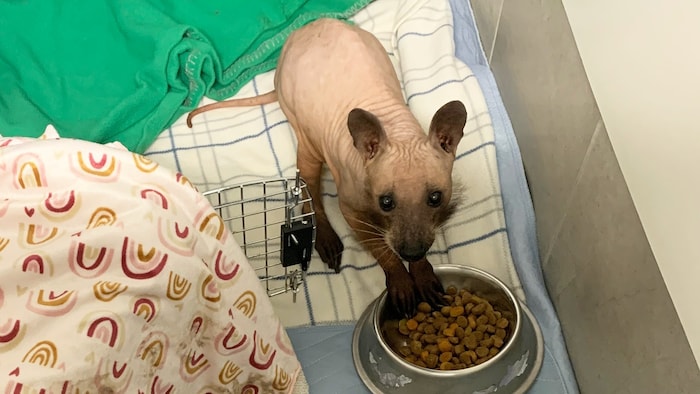Open in full screen mode A hairless raccoon was caught in West Arichat, Cape Breton, and brought to a wildlife reserve in Nova Scotia where he is examined and treated. Radio-Canada Speech synthesis, based on artificial intelligence, makes it possible to generate spoken text from written text. A small pink creature without fur ventured into Jamie Forgeron's backyard in Cape Breton to eat her cat food. She had never seen that before, but she was sure it wasn't one of her feline friends. [My husband] went out to feed the cats and he was hiding behind our generator, behind our house, and he ran out and scared him, says Jamie Smith. It was a raccoon, furless and shivering, looking for food. Even though the raccoon didn't appear to be in distress, the couple wanted to do something to help it. Jamie Forgeron was worried about her health and the risk of frostbite due to the cold. So she called Hope For Wildlife, a center wildlife rehabilitation center in Seaforth, Nova Scotia, to see if they could accommodate him. When they said yes, the couple set up a live trap and baited the raccoon with cat food.
The hairless raccoon was named Rufus after the fictional hairless animal character in Disney's animated television series, Kim Possible.
He was very calm, assures the lady from Arichat-Ouest. It was almost as if he knew he was going to get help.
Hope Swinimer, founder of Hope For Wildlife, confirms the raccoon is safe at her shelter and has been affectionately named Rufus, after the fictional furless animal character from the ;children's television show, Kim Possible.
Loading
Putin poised to overtake Stalin
ELSE ON NEWS: Putin poised to overtake StalinLoading
Putin on the verge of overtaking Stalin
ELSE ON NEWS: Putin on the verge of overtaking Stalin
Staff initially believed the raccoon was male, but after being given anesthesia for dermatological testing on Thursday, they confirmed it was female.
Hope Swinimer, from Hope for Wildlife, which specializes in wildlife rehabilitation, in Seaforth, Nova Scotia.
Hope Swinimer says the animal is doing well, is generally healthy and quite feisty, but is simply missing some hair, which could be caused by a condition called alopecia.
The center will still check if the female suffers from a parasite, scabies or a fungal infection. Without knowing what's wrong, Hope Swinimer can't really predict what will happen to the animal.
Under good supervision and with a good diet, some of its fur may grow back and it could be released, she says.
Otherwise, Hope Swinimer says the beast could live at the rehabilitation center.
A life in captivity would not be our first choice because we have to give him a quality of life, she admits . But you know, things can be done and beautiful habitats can be built.
With information from Cassidy ChisholmofCBC

